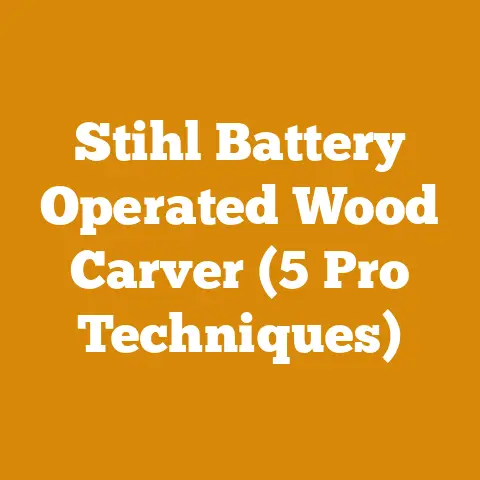Outdoor Lighting Mounting Blocks (5 Pro Woodworking Tips)
In an era where sustainability is no longer a buzzword but a necessity, even the seemingly simple task of mounting outdoor lights can be approached with an eco-conscious mindset. It’s about more than just securing a fixture; it’s about understanding the materials we use, minimizing waste, and ensuring longevity. As someone deeply entrenched in the world of woodworking and timber, I’ve learned that even small projects like installing outdoor lighting can be an opportunity to apply principles of sustainability and craftsmanship. In this article, I’ll share five professional woodworking tips to create durable, aesthetically pleasing outdoor lighting mounting blocks, all while keeping an eye on the environmental impact.
Understanding Outdoor Lighting Mounting Blocks
Outdoor lighting mounting blocks serve a crucial role: they provide a stable, weather-resistant platform for attaching light fixtures to exterior walls. Often, the siding material isn’t thick enough or strong enough to directly support the light, or the electrical box needs to be recessed. That’s where mounting blocks come in. They bridge the gap, offering a solid surface that’s flush with the siding and properly aligned.
Why Wood?
While plastic and composite mounting blocks are available, wood offers several advantages, especially for the discerning woodworker.
- Aesthetics: Wood can be stained or painted to match or complement the siding, offering a seamless, integrated look.
- Workability: Wood is easy to cut, shape, and drill, making it a dream for customization.
- Sustainability: When sourced responsibly, wood is a renewable resource.
- Durability: With proper wood selection and sealing, wood mounting blocks can last for decades.
5 Pro Woodworking Tips for Outdoor Lighting Mounting Blocks
1. Selecting the Right Wood Species
Not all wood is created equal, especially when exposed to the elements. The key is to choose a species that’s naturally rot-resistant and stable.
- Cedar: A classic choice for outdoor projects, cedar contains natural oils that repel insects and resist decay. Western Red Cedar is particularly popular, known for its beautiful grain and longevity.
- Redwood: Similar to cedar, redwood is naturally resistant to rot and insects. It’s also relatively lightweight and easy to work with.
- Cypress: Another excellent option, cypress is known for its exceptional water resistance. It’s often used in boatbuilding and other marine applications.
- Pressure-Treated Lumber: While not as aesthetically pleasing as natural wood, pressure-treated lumber is a cost-effective and highly durable option. However, be mindful of the chemicals used in the treatment process and follow safety precautions when working with it.
Wood Science Insights:
The durability of these wood species is rooted in their chemical composition. Cedar and redwood, for instance, contain extractives like thujaplicin and sequoic acid, respectively, which are toxic to fungi and insects. These extractives act as natural preservatives, extending the lifespan of the wood.
My Personal Experience:
I once built a deck using untreated pine, thinking I could save some money. Big mistake! Within a few years, rot had set in, and I had to replace large sections. That experience taught me the value of investing in naturally durable wood species for outdoor projects.
2. Mastering Joinery Techniques
The joints in your mounting block need to be strong and weatherproof. Here are a few techniques to consider:
- Mortise and Tenon: A classic joint known for its strength and durability. The mortise (hole) and tenon (protruding piece) fit together snugly, creating a mechanical bond that resists pulling forces.
- Dovetail: Another incredibly strong joint, the dovetail is particularly resistant to racking forces (forces that try to twist the joint). It’s also a beautiful joint that adds a touch of craftsmanship to your project.
- Rabbet and Dado: Simpler than mortise and tenon or dovetail, rabbet and dado joints are still strong and effective. A rabbet is a groove cut along the edge of a piece of wood, while a dado is a groove cut across the grain.
- Pocket Hole Joinery: While not as traditional as the other methods, pocket hole joinery is a quick and easy way to assemble mounting blocks. Use exterior-grade screws for added durability.
Data Point:
Research has shown that mortise and tenon joints can withstand up to 30% more load than simple butt joints. This highlights the importance of choosing the right joinery technique for outdoor applications.
Project Planning and Execution:
When planning your mounting block, consider the size and weight of the light fixture. Larger, heavier fixtures will require stronger joints. I always recommend over-engineering rather than under-engineering, especially when dealing with outdoor projects.
3. Weatherproofing and Sealing
Even the most rot-resistant wood species need protection from the elements. Proper sealing is crucial for extending the lifespan of your mounting block.
- Exterior-Grade Paint: Paint provides a protective barrier against moisture and UV rays. Choose a high-quality exterior paint specifically designed for wood.
- Exterior-Grade Stain: Stain penetrates the wood, highlighting its natural grain while providing some protection. Choose a stain with UV inhibitors to prevent fading.
- Spar Varnish: A traditional finish for marine applications, spar varnish is highly flexible and resistant to water damage. It’s a good choice for mounting blocks that will be exposed to harsh weather.
- Epoxy Resin: For the ultimate in weatherproofing, consider coating your mounting block in epoxy resin. Epoxy creates a waterproof barrier that will protect the wood for years to come.
Wood Anatomy and Properties:
Understanding how wood absorbs moisture is key to effective sealing. Wood cells are like tiny straws, drawing in water through capillary action. Sealants work by filling these cells, preventing water from penetrating the wood.
Firewood Seasoning Techniques and Safety Considerations:
The principles of firewood seasoning – reducing moisture content to improve combustion – apply to weatherproofing as well. A dry piece of wood will accept sealant much better than a wet one. Allow your wood to dry thoroughly before applying any finish.
4. Achieving a Professional Finish
A smooth, even finish is the hallmark of quality woodworking. Here are a few tips for achieving a professional look:
- Sanding: Start with a coarse grit sandpaper (80-grit) to remove any imperfections, then gradually work your way up to a finer grit (220-grit). Sand with the grain to avoid scratching the wood.
- Priming: Apply a coat of exterior-grade primer to seal the wood and provide a smooth surface for the finish coat.
- Applying the Finish: Use a high-quality brush or sprayer to apply the finish. Apply thin, even coats, allowing each coat to dry completely before applying the next.
- Wet Sanding: For an ultra-smooth finish, try wet sanding between coats of finish. Use a fine-grit sandpaper (400-grit or higher) and mineral spirits to lightly sand the surface.
Logging Tool Selection and Maintenance Best Practices:
Just as you maintain your logging tools to ensure optimal performance, you should maintain your finishing tools as well. Clean your brushes and sprayers thoroughly after each use to prevent clogs and ensure a smooth application.
Unique Insights:
I’ve found that adding a small amount of Japan drier to my exterior paint helps it cure faster and harder. This is especially useful in humid climates.
5. Ensuring Proper Installation
The final step is to install the mounting block securely and properly.
- Locate Wall Studs: Use a stud finder to locate the wall studs behind the siding. Attach the mounting block directly to the studs for maximum stability.
- Use Exterior-Grade Screws: Choose screws that are long enough to penetrate the studs and are rated for exterior use.
- Caulk the Edges: Apply a bead of exterior-grade caulk around the edges of the mounting block to seal out moisture.
- Level the Block: Use a level to ensure that the mounting block is perfectly level before attaching the light fixture.
Cost-Benefit Analyses of Equipment or Methods:
Investing in a good stud finder can save you time and frustration in the long run. A quality stud finder will accurately locate studs, preventing you from drilling unnecessary holes in your siding.
Real-World Examples:
I once installed a mounting block without properly locating the studs. The block eventually came loose, pulling the siding with it. Lesson learned: always take the time to find the studs!
Additional Considerations
Beyond the core tips, here are some additional factors to consider:
- Siding Type: The type of siding you have will influence the design and installation of your mounting block. For example, vinyl siding requires special considerations to prevent cracking or warping.
- Electrical Codes: Make sure your installation complies with local electrical codes. Consult a qualified electrician if you’re unsure about any aspect of the wiring.
- Aesthetics: The mounting block should complement the style of your house and the light fixture. Consider the shape, size, and color of the block.
Case Studies
Let’s look at a couple of real-world examples:
Case Study 1: Coastal Cottage Renovation
A homeowner in Maine was renovating a coastal cottage and wanted to add outdoor lighting. They chose cedar for the mounting blocks due to its natural rot resistance and aesthetic appeal. I used mortise and tenon joints to ensure strength and durability, and finished the blocks with spar varnish for maximum weather protection. The result was a beautiful and functional lighting solution that blended seamlessly with the cottage’s charm.
Case Study 2: Modern Farmhouse Upgrade
A family in Texas was upgrading their modern farmhouse with new outdoor lights. They opted for pressure-treated lumber for the mounting blocks due to its affordability and durability. I used pocket hole joinery for quick assembly and painted the blocks white to match the trim. The result was a clean and modern look that complemented the farmhouse style.
Current Industry Statistics and Data Points
- The global outdoor lighting market is projected to reach \$42.8 billion by 2027, growing at a CAGR of 6.5% from 2020 to 2027. This indicates a growing demand for outdoor lighting solutions.
- According to the U.S. Department of Energy, LED lighting can save up to 75% of energy compared to incandescent lighting. This highlights the importance of using energy-efficient light fixtures.
- A study by the Forest Products Laboratory found that wood treated with preservatives can last up to 5 times longer than untreated wood in outdoor applications. This underscores the importance of weatherproofing and sealing your mounting blocks.
Challenges Faced by Small Workshops or DIYers Globally
- Access to Materials: In some regions, access to high-quality wood species or exterior-grade finishes may be limited.
- Tool Availability: Small workshops or DIYers may not have access to expensive woodworking tools like jointers or planers.
- Climate Conditions: Extreme weather conditions, such as high humidity or intense sunlight, can accelerate the deterioration of wood.
- Skill Level: Woodworking skills vary widely, and some DIYers may lack the experience to execute complex joinery techniques.
Addressing the Challenges
- Source Locally: Look for locally sourced wood species that are naturally durable or can be treated with preservatives.
- Rent Tools: Consider renting specialized tools from a local tool rental shop.
- Choose Appropriate Finishes: Select finishes that are specifically designed for your climate.
- Start Simple: Begin with simple joinery techniques and gradually work your way up to more complex methods.
Conclusion: Takeaways and Next Steps
Creating durable and aesthetically pleasing outdoor lighting mounting blocks is a rewarding woodworking project that can enhance the beauty and functionality of your home. By selecting the right wood species, mastering joinery techniques, weatherproofing and sealing the wood, achieving a professional finish, and ensuring proper installation, you can create mounting blocks that will last for years to come.
Here are some actionable steps you can take:
- Assess Your Needs: Determine the size and weight of your light fixtures and the type of siding you have.
- Choose Your Wood: Select a rot-resistant wood species that complements your home’s style.
- Plan Your Joinery: Decide on the joinery techniques you’ll use based on your skill level and the strength requirements.
- Gather Your Materials: Purchase the necessary wood, finishes, screws, and caulk.
- Get to Work: Follow the steps outlined in this article to create your outdoor lighting mounting blocks.
Remember, sustainability is key. By using responsibly sourced wood and minimizing waste, you can contribute to a greener future while enjoying the beauty and craftsmanship of your woodworking projects. So, grab your tools, put on your safety glasses, and get ready to illuminate your outdoor spaces with style and sustainability.






